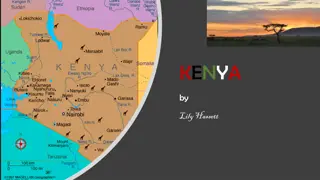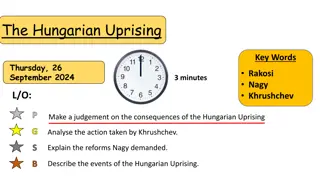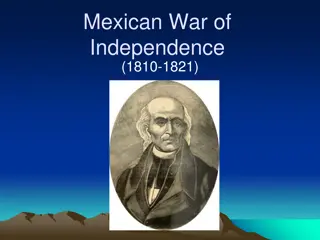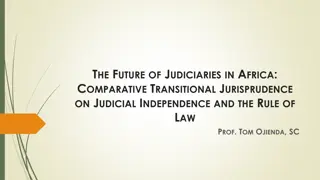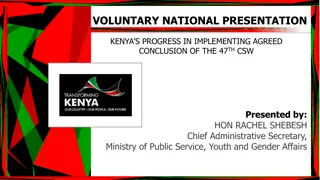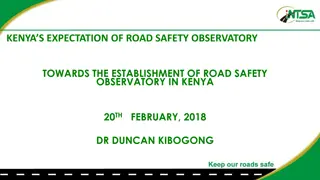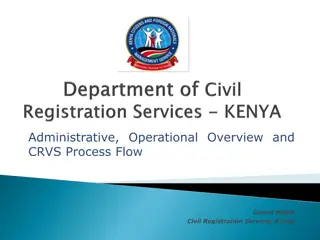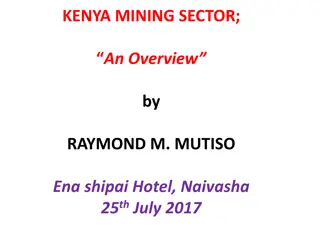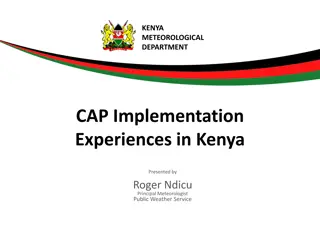The Mau Mau Uprising in Kenya: A Struggle for Independence
The Mau Mau Uprising in Kenya, also known as the Mau Mau Rebellion, was a significant resistance movement against British colonial rule. Initiated by the Kikuyu ethnic group but involving various tribes, it was fueled by grievances over land dispossession and mistreatment. The rebellion escalated into violent conflict, resulting in a state of emergency being declared by the British colonial administration. The Mau Mau Rebellion ultimately symbolized the ongoing struggle for freedom and independence in Kenya.
Download Presentation

Please find below an Image/Link to download the presentation.
The content on the website is provided AS IS for your information and personal use only. It may not be sold, licensed, or shared on other websites without obtaining consent from the author. Download presentation by click this link. If you encounter any issues during the download, it is possible that the publisher has removed the file from their server.
E N D
Presentation Transcript
Africans Resist Colonialism: The Mau Mau Story Breeanna Elliott NERC 2016 Mzungu Arudi Ulaya, Mwafrika Apate Uhuru
The Rise of Anti-Imperialism - Most colonies had an African elite who had a European education initially supportive of mother country but later became leaders of independence - During the world wars, the colonies were needed to provide resources (foodstuffs) AND soldiers - European powers promised reforms (and greater independence) for colonies if they helped the mother country - The reforms never came and after the Great Depression, the colonies were given no assistance or aid led to resistance
Africa is a Continent: Highlighting Kenya British established the East Africa Protectorate in 1895 Considered as a settler colony white settlers took the best land for their own and moved native groups to reserves In 1920, it became known as the Kenya Colony Kenya received its independence in 1963
Mau Mau Uprising - Review Initiated by an ethnic group known as the Kikuyu but grew to include many different ethnic groups in Kenya Biggest frustration: LAND supposedly vacant land was taken over by the British settlers Africans, especially the Kikuyu who traditionally occupied the most fertile lands, were forcibly removed and placed in resource-poor areas Initial attempts at peaceful negotiations failed resistance became violent as British resorted to detention camps and the Mau Mau became a mythical source of inspiration to many Kenyans
The Mau Mau Rebellion (1953-56): A Case Study
Resistance An Ongoing Struggle In the 1940s members of the Kikuyu, Embu, Meru, and Kamba tribes took oaths to fight for freedom Increasing British concern about the resistance led them to jail Jomo Kenyatta (future 1st president of Kenya) as a leader of the Mau Mau in 1953. Led to a state of emergency being declared Oct 1952 Dec 1959 Officially, the number of rebels killed included 11,000, including 1,090 hangings. The Kenya Human Rights Commission says 90,000 Kenyans were executed, tortured or maimed during the crackdown, and 160,000 were detained in appalling conditions. Only 32 white settlers were killed.
Impact of the Resistance - Legacies Undoubtedly the Mau Mau rebellion contributed to the expediency of Kenyan independence 2013 - legal suit against the British government on behalf of the Mau Mau survivors paid out 19.9m to 5,228 Kenyans who were victims of torture 2016 - new legal suit against the British government on behalf of those affected by additional offenses (e.g., false imprisonment, forced labor, interruption to their right to education)


